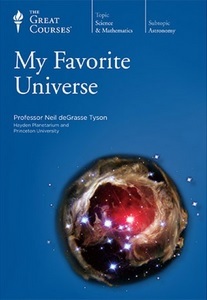The Great Courses delivers again, featuring a series of Neil deGrasse Tyson lectures based on articles he published. Tyson’s talks are readily accessible for the lay audience, simultaneously intellectually engaging, awe-inspiring, and entertaining. Basic fundamentals include density, quantum theory, gravity, and general relativity. He touches on chemistry, biology, and geology in order to supplement the astronomy lectures that tell a story from the Big Bang to the end of the universe, with a few black holes in the middle.
Tyson excels in communicating the big picture.
- Earth’s deepest sea and tallest mountain ranges are astonishing distances to us, but from a cosmic standpoint, they are miniscule. If a giant were to pick up the Earth as if it were a marble, the tallest mountain ridge would be smaller than the indentation of it’s fingerprint. The Earth would feel as smooth as a ball bearing.
- You have the same chance of dying in a plane crash as the entire world population of dying from an asteroid collision with the Earth. This is what keeps Tyson up at night.
- The panorama of planets and stars revealed by the Hubble Space Telescope estimates that there are more Earth-like planets in the universe than there are grains of sand on all the beaches of Earth. Regardless, Tyson isn’t worried about contact anytime soon.
These lectures are likely too simple for anyone familiar with basic scientific concepts. The chemistry covered includes that carbon is a “sticky” atom, capable of combining in more ways than all other elements, allowing for more combinations of molecules. In addition, the lectures lack the narrative structure of the finely honed works of Tyson today, especially his 2014 television series Cosmos.
Highly recommended for non-scientists looking for an engaging and accessible introduction to astrophysics!
